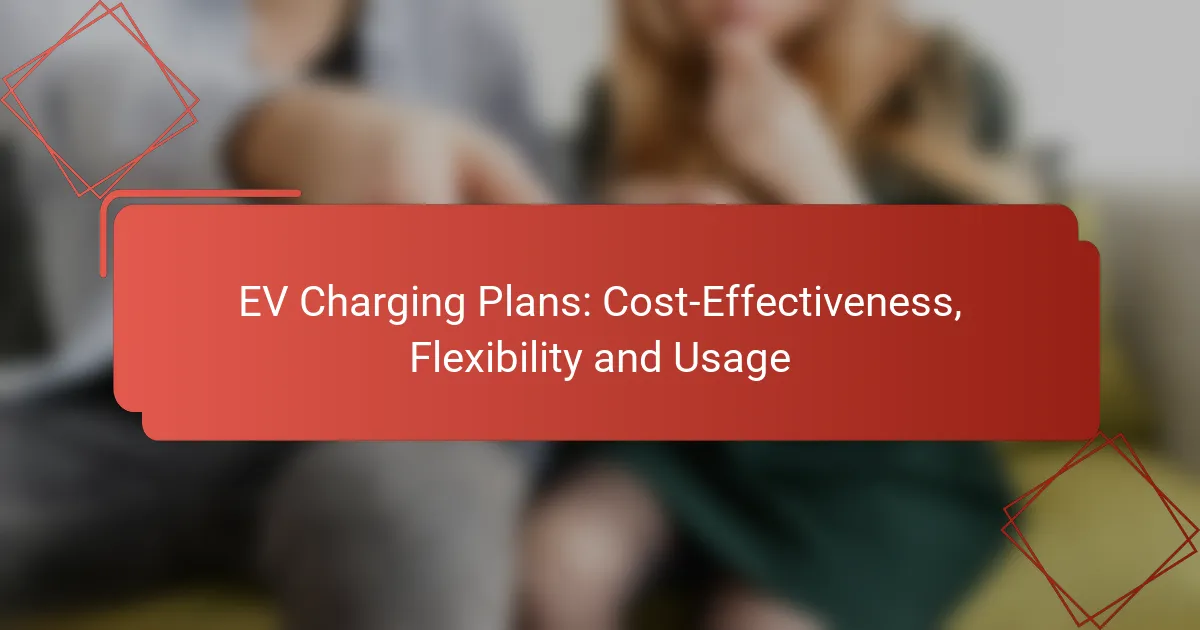As electric vehicle (EV) adoption continues to rise, cost-effective charging plans are becoming essential for minimizing expenses while maximizing convenience for owners. These plans offer flexibility, allowing users to select options tailored to their driving habits and lifestyles, including various home and public charging solutions. By understanding usage patterns, EV owners can further optimize their charging habits to enhance both cost-effectiveness and convenience.
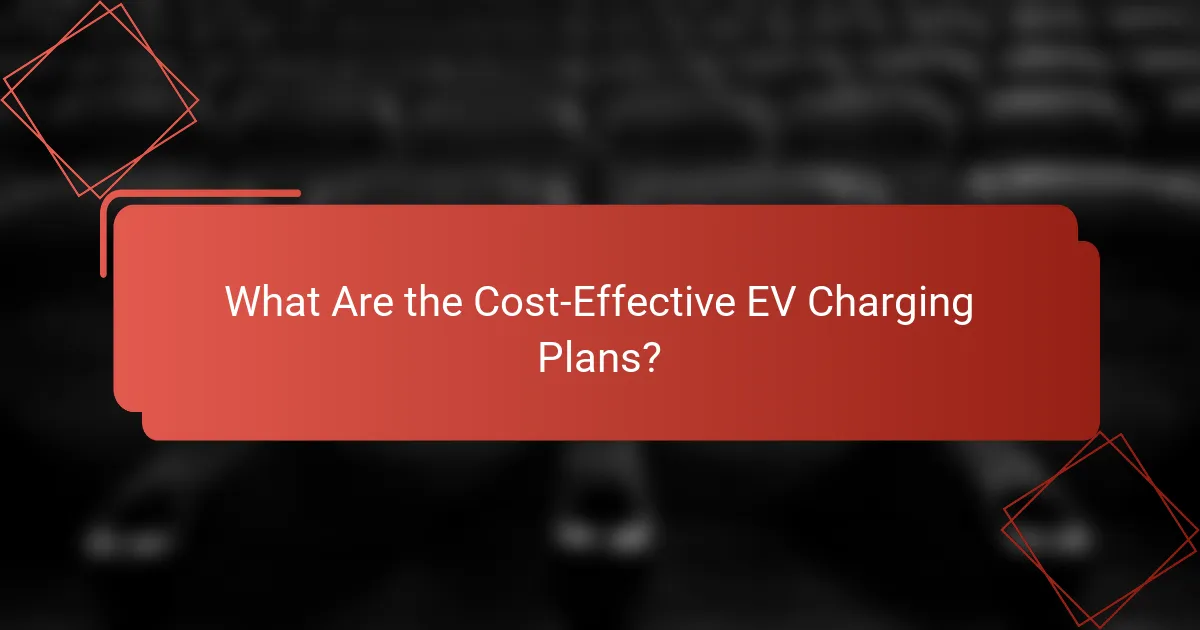
What Are the Cost-Effective EV Charging Plans?
Cost-effective EV charging plans are designed to minimize expenses while maximizing convenience for electric vehicle owners. These plans vary in structure, allowing users to choose options that best fit their driving habits and budget.
Subscription-based plans
Subscription-based plans involve a monthly fee that grants users access to a network of charging stations. This model is beneficial for frequent drivers, as it often includes unlimited charging or a set number of charging sessions. Users should compare subscription costs against their average monthly charging needs to determine if this option is financially advantageous.
For example, a subscription might cost around $30 to $50 per month, which can be worthwhile for those who charge multiple times a week. However, casual users may find this plan less economical compared to other options.
Pay-per-use options
Pay-per-use options charge users based on the amount of electricity consumed during each charging session. This model is straightforward and ideal for infrequent users who do not want to commit to a monthly fee. Rates typically range from $0.10 to $0.40 per kWh, depending on the charging station and location.
While pay-per-use can be cost-effective for occasional drivers, it’s essential to monitor usage to avoid unexpected high costs, especially during peak hours when rates may increase.
Flat-rate monthly fees
Flat-rate monthly fees provide a predictable cost for charging, regardless of usage. Users pay a fixed amount each month, which can simplify budgeting. This option is suitable for those who charge regularly but want to avoid fluctuating costs associated with pay-per-use models.
Typically, flat-rate fees range from $50 to $100 per month. It’s crucial to assess personal charging habits to ensure that this plan does not lead to overpayment compared to other pricing structures.
Dynamic pricing models
Dynamic pricing models adjust rates based on demand, time of day, or other factors. This approach can lead to significant savings during off-peak hours when rates are lower. Users who can charge their vehicles during these times may find dynamic pricing to be the most economical option.
However, this model requires users to be flexible and aware of pricing fluctuations. It’s advisable to use apps or tools that provide real-time pricing information to maximize savings and avoid charging during peak times when costs are higher.
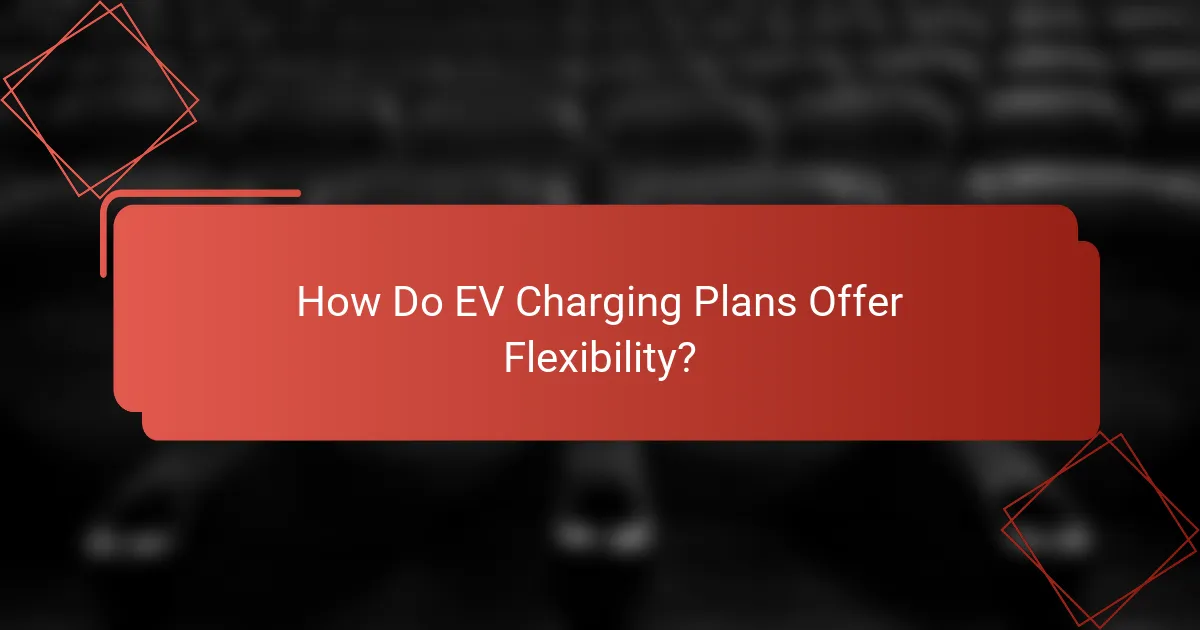
How Do EV Charging Plans Offer Flexibility?
EV charging plans provide flexibility by allowing users to choose charging options that best fit their lifestyle and driving habits. These plans often include various home and public charging solutions, as well as mobile app management features that enhance user control and convenience.
Home charging solutions
Home charging solutions typically involve installing a Level 2 charger, which can significantly reduce charging time compared to standard outlets. Many plans offer incentives for home installation, making it more affordable. Users can charge their vehicles overnight, taking advantage of lower electricity rates during off-peak hours.
Consider the cost of installation, which can range from a few hundred to over a thousand USD, depending on the complexity of the setup. It’s essential to check if your utility provider offers rebates or incentives for home charging installations.
Public charging network access
Access to a public charging network is crucial for EV owners who frequently travel longer distances. Many charging plans include memberships to networks that provide fast chargers, allowing for quicker refueling on the go. Users should evaluate the coverage and availability of charging stations in their area to ensure convenience.
Some networks operate on a pay-per-use basis, while others may offer subscription models. It’s advisable to compare the costs and benefits of each option, especially if you plan to use public charging frequently.
Mobile app management
Mobile app management features allow users to monitor and control their charging sessions remotely. Many EV charging plans come with dedicated apps that provide real-time updates on charging status, cost estimates, and even the ability to schedule charging times to take advantage of lower rates.
When choosing a plan, look for apps that offer user-friendly interfaces and additional features like locating nearby charging stations or tracking energy consumption. This can enhance your overall charging experience and help you manage costs effectively.
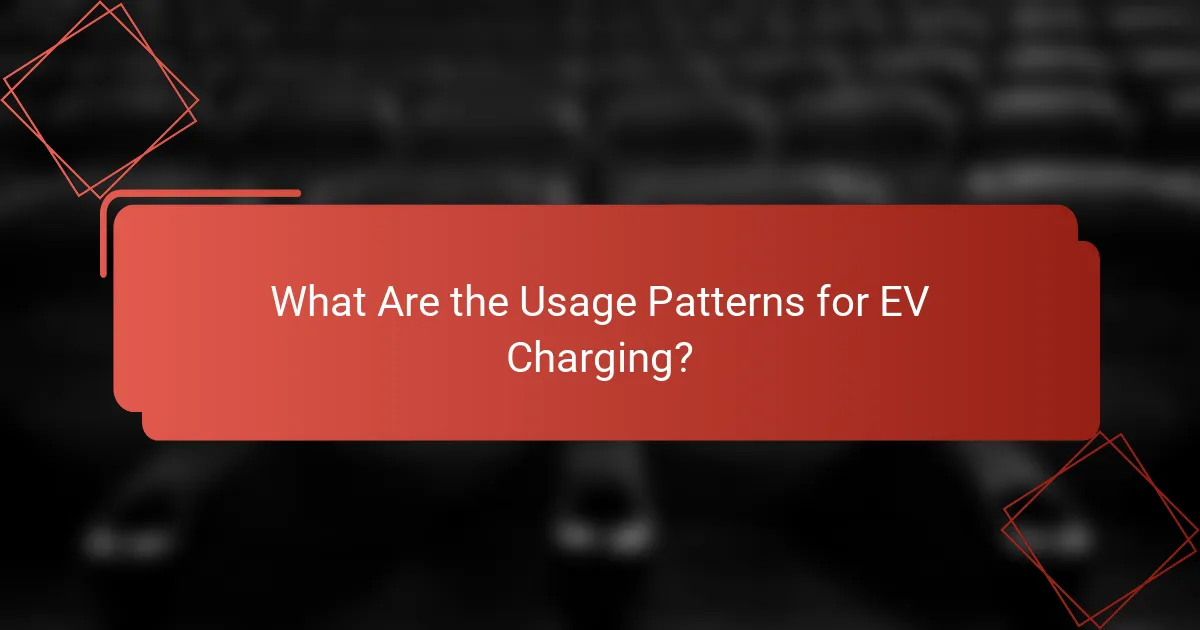
What Are the Usage Patterns for EV Charging?
Usage patterns for EV charging vary significantly based on time of day, frequency of charging, and location. Understanding these patterns can help EV owners optimize their charging habits for cost-effectiveness and convenience.
Peak vs. off-peak charging
Peak charging occurs during high-demand hours, typically in the evening when most people return home from work. During these times, electricity rates can be significantly higher, making it more expensive to charge an EV.
Off-peak charging, on the other hand, takes place during low-demand periods, often late at night or early in the morning. Many utility companies offer lower rates during these hours, allowing EV owners to save money by scheduling their charging accordingly.
Charging frequency
The frequency of charging depends on individual driving habits and the range of the EV. Most drivers find that charging every few days is sufficient, while others may need to charge daily if they have longer commutes.
Establishing a routine can help optimize charging frequency. For example, charging overnight at home can ensure the vehicle is ready each morning without the need for frequent stops at public charging stations.
Location-based usage trends
Location plays a crucial role in EV charging patterns. Urban areas often have more public charging stations, leading to higher usage rates compared to rural locations. In cities, EV owners may rely on public chargers during the day while charging at home overnight.
In contrast, rural drivers may charge less frequently due to fewer available charging options. Understanding local charging infrastructure can help EV owners plan their trips and charging schedules more effectively.
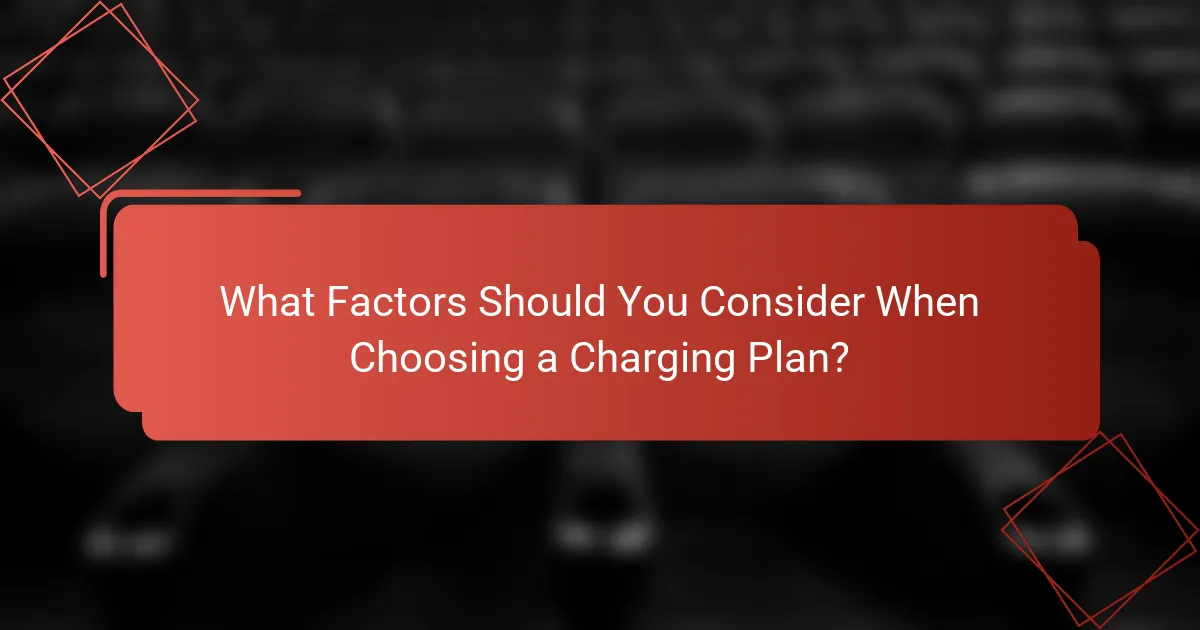
What Factors Should You Consider When Choosing a Charging Plan?
When selecting an EV charging plan, consider cost, charging speed, and network coverage. These factors significantly impact your overall experience and expenses related to electric vehicle ownership.
Cost comparison
Cost is a primary factor when evaluating charging plans. Monthly fees, per-kWh rates, and additional charges can vary widely among providers. For instance, some plans may offer lower rates during off-peak hours, while others might have a flat fee regardless of usage.
To determine the most cost-effective option, analyze your driving habits. If you drive frequently, a plan with a lower per-kWh rate might save you more money over time. Conversely, if you charge infrequently, a pay-as-you-go plan could be more economical.
Charging speed
Charging speed affects how quickly you can recharge your vehicle. There are three main levels of charging: Level 1 (standard household outlets), Level 2 (dedicated charging stations), and DC fast charging. Level 1 is the slowest, providing about 3-5 miles of range per hour, while DC fast chargers can deliver up to 80% charge in around 30 minutes.
When choosing a plan, consider your daily driving needs. If you often require quick top-ups, prioritize plans that provide access to fast charging networks. However, if you have overnight charging capabilities, a slower plan may suffice.
Network coverage
Network coverage is crucial for ensuring you can charge your vehicle when needed. Some charging plans offer access to extensive networks, while others may be limited to specific areas. Check the provider’s coverage map to see if it aligns with your typical routes.
Additionally, consider the availability of charging stations in your region. A plan with a robust network in urban areas might not be as beneficial if you frequently travel to rural locations. Always verify that the charging stations are compatible with your vehicle to avoid inconvenience.
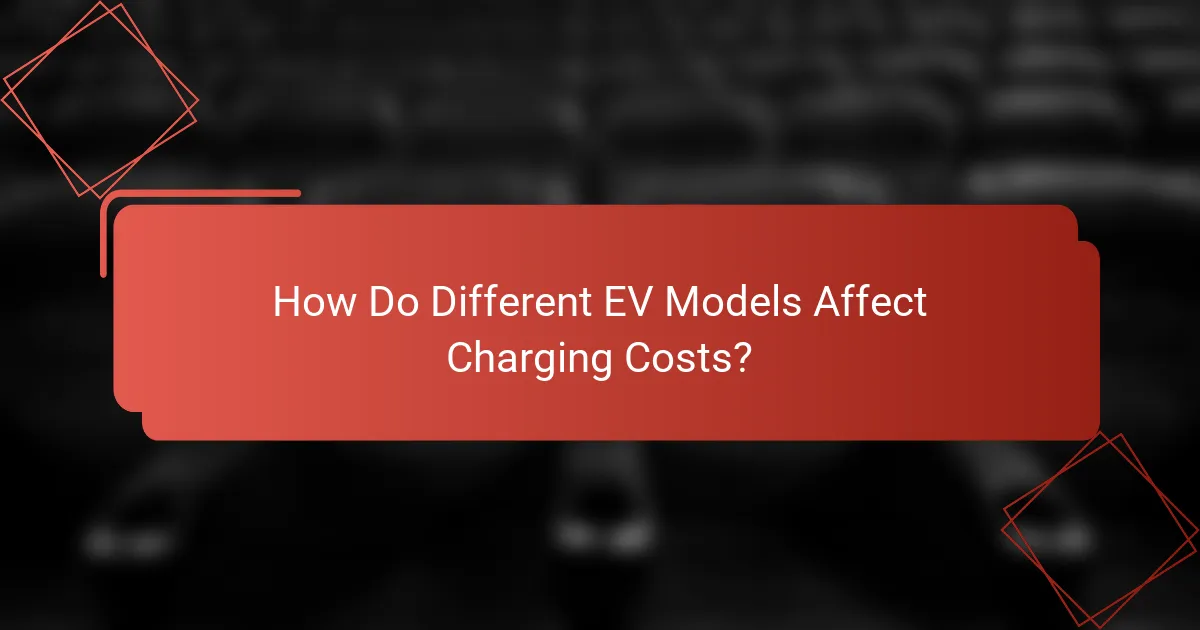
How Do Different EV Models Affect Charging Costs?
Different electric vehicle (EV) models can significantly influence charging costs due to variations in battery size, charging compatibility, and manufacturer-specific plans. Understanding these factors helps EV owners make informed decisions about their charging strategies and associated expenses.
Battery size impact
The size of an EV’s battery directly affects charging costs. Larger batteries typically require more energy to charge, leading to higher electricity bills. For instance, a vehicle with a 60 kWh battery may cost more to charge than one with a 40 kWh battery, depending on local electricity rates.
When considering charging costs, it’s essential to factor in the battery’s capacity and the efficiency of the vehicle. A more efficient model may consume less energy per mile, offsetting some of the higher charging costs associated with a larger battery.
Charging compatibility
Charging compatibility varies among EV models, impacting overall charging costs. Some vehicles support fast charging, which can reduce charging time but may come with higher per-kWh rates at charging stations. In contrast, standard charging options are generally more economical but take longer.
Additionally, compatibility with different charging networks can affect costs. EV owners should check which networks their vehicle supports and whether they offer subscription plans or pay-as-you-go options, as these can lead to significant savings.
Manufacturer-specific plans
Many EV manufacturers offer specific charging plans that can influence overall costs. For example, some brands provide free charging for a limited time or discounted rates at partner charging stations. These plans can significantly reduce expenses, especially for new owners.
It’s advisable to review the terms of any manufacturer-specific charging plan before purchasing an EV. Understanding the details, such as duration and location limitations, can help maximize savings and ensure that the charging plan aligns with your driving habits.
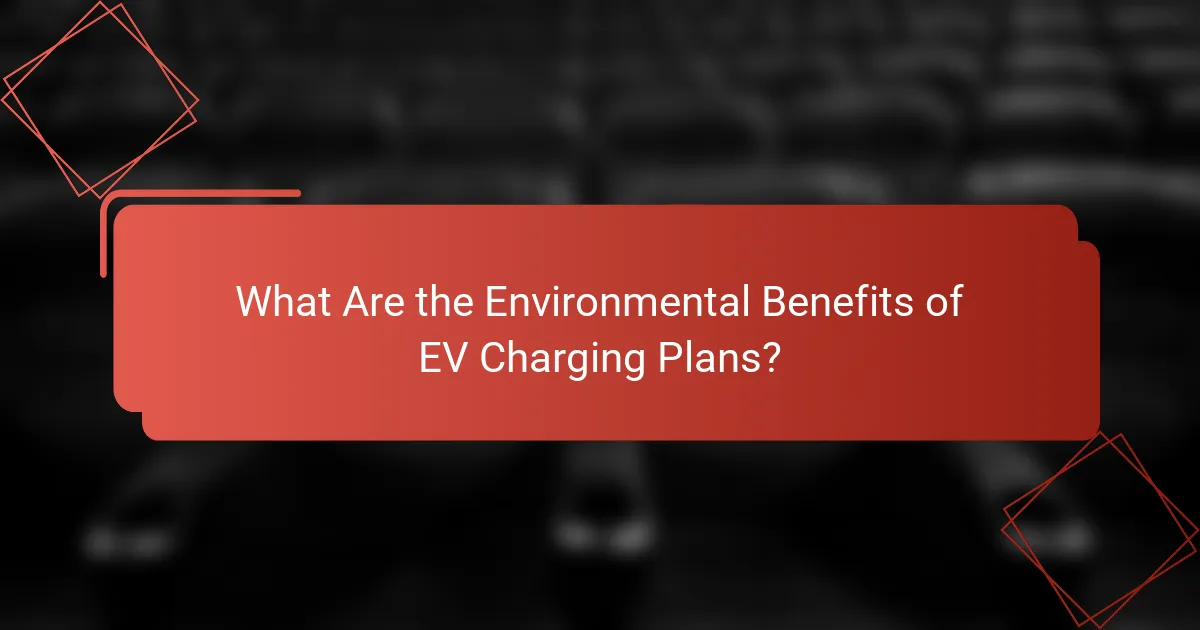
What Are the Environmental Benefits of EV Charging Plans?
EV charging plans contribute significantly to environmental sustainability by promoting the use of electric vehicles (EVs) and reducing greenhouse gas emissions. These plans encourage cleaner energy sources and facilitate the transition to a more sustainable transportation system.
Reduction in carbon footprint
One of the primary environmental benefits of EV charging plans is the reduction in carbon footprint associated with electric vehicles. By replacing traditional gasoline or diesel vehicles with EVs, emissions from fossil fuels are significantly lowered, leading to cleaner air and reduced climate change impacts.
Charging plans that utilize renewable energy sources, such as solar or wind, further enhance this benefit. When EVs are charged using green energy, the overall lifecycle emissions decrease, making the transportation sector more sustainable. For instance, charging an EV with solar energy can reduce emissions by up to 80% compared to conventional vehicles.
To maximize the reduction in carbon footprint, consumers should consider charging during off-peak hours when renewable energy is more likely to be available. Additionally, selecting a charging plan that prioritizes green energy can amplify the positive environmental impact of driving an electric vehicle.
